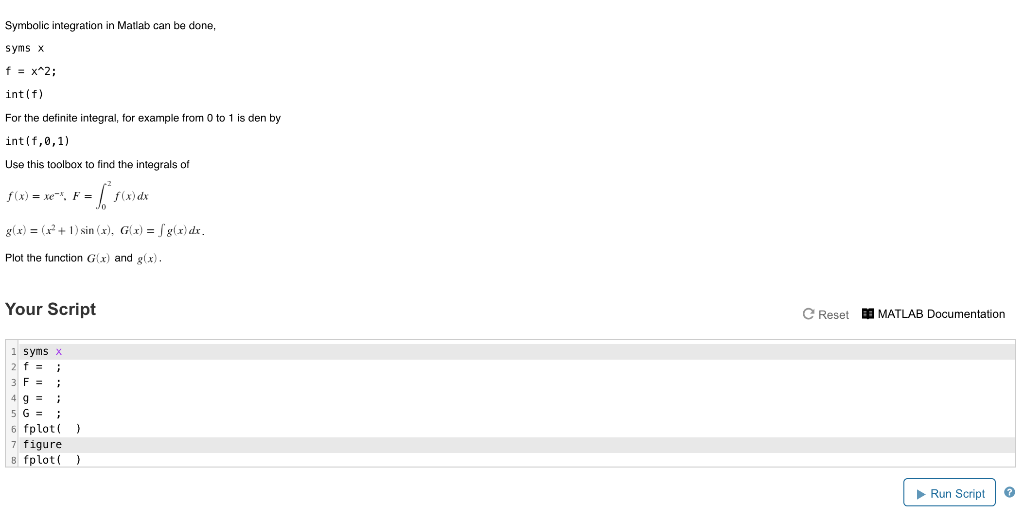


K5=exp((1044.78)+(-45171.42/T)+(-165.20*log(T)+(0. For example, syms a 1 3 creates the symbolic array a a1 a2 a3 and the symbolic scalar variables a1, a2, and a3 in the MATLAB ® workspace. If I could please get some help syms a b c d If we have a matrix A having the following values. You can use the same technique to find the derivative of a matrix.
#MATLAB SYMS HOW TO#
On solving it, it is showing error as given below Error in syms (line 201)Īnother doubt I am having is, I need to run this code with more than one values of x1, x2, x3, and T (vectors), for which I was trying to apply for loop but I am not getting how to generate vectors of symbols using syms accurately and how will statements(such as S.a(S.a<0)=)in code will change in code. syms x y f sin(xy) diff(f,x) which returns. In particular, if you shadow a function name, you may get hard-to-track-down bugs. Caution: On Matlab, you may not want to use syms within functions. Called without arguments, syms displays a list of all symbolic functions defined in the current workspace. MATLAB codeĮxample 3: Reconsider Example 1 at the top of the page.I need to solve some equations using syms. Here x is created in the callers workspace, as a side effect. If all variables are given numerical values, the answer is a number in MATLAB, not “Maple”.Įxample 2: Let us compare simple MATLAB and “Maple” codes which both evaluate the expression y = (x 3 + 2) sec x at x = 0.123. It is of the form ans=eval(S) where S is a symbolic expression for which at least one of its symbolic variables has just been given a value. The result g is still a symbolic variable or symbolic constant in “Maple”.Įxample 1: Consider a function of the two Cartesian coordinates f(x, y) =Ĭhange to polar coordinates using x = r cos θ, y = r sin θ and then determine the value of f at an arbitrary point on the unit circle r = 1.į=subs(f,) Īn alternative is to use the eval command. Then you can use the general subs command g=subs(f,old,new) which in our cases would be g=subs(f,x,c) or g=subs(f,x,x0). If all variables are given numerical values, the answer. If you declare a variable using syms, existing assumptions are cleared. You get a fresh symbolic variable with no assumptions. It is of the form anseval (S) where S is a symbolic expression for which at least one of its symbolic variables has just been given a value. Use syms to create a symbolic variable that is assigned to a MATLAB variable with the same name.
#MATLAB SYMS PRO#
fonunitcirclesin (2theta) An alternative is to use the eval command. thats what i got - MATLAB Version: 8.3.0.532 (R2014a) MATLAB License Number: STUDENT Operating System: Microsoft Windows 8.1 Pro Version 6.3 (Build 9600) Java Version: Java 1.7.


Suppose you have a symbolic expression f which includes the symbol x and you wish to substitute for x another symbol c or a numerical value x0. fonunitcirclesubs (F,r,1) which gives the output. Sym() can also be used to refer to an existing symbolic variable and current assumption associated with the variable. Symbolic numbers generated from the sym() function are the exact representations of the input numbers. Variable substitution and expression evaluation: subs, eval The sym() in MATLAB is used to create numbered symbolic variables or symbolic variables in different MATLAB functions.


 0 kommentar(er)
0 kommentar(er)
